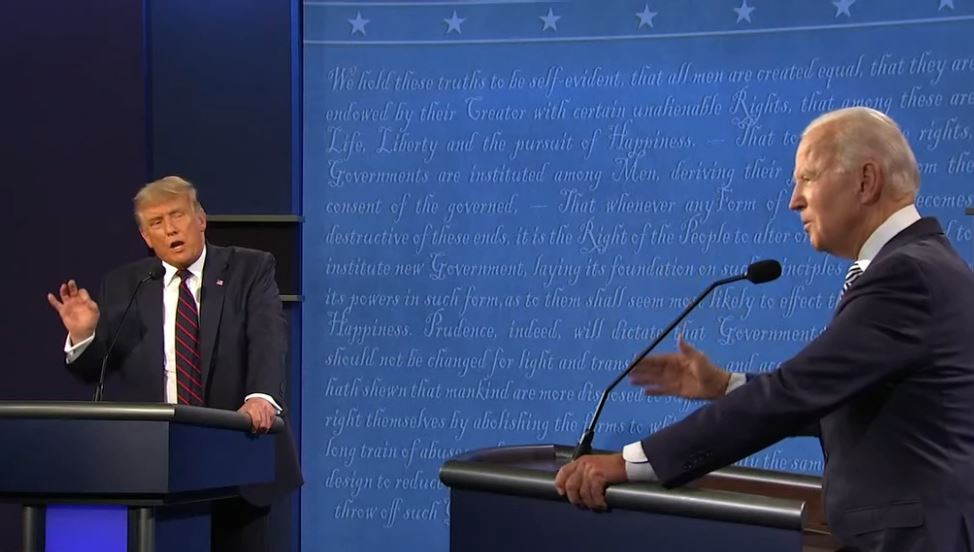The first presidential debate this week was a raucous affair and included the topic of “climate change” in the final half-hour of the nearly 100-minute event. The differences between the candidates were informative.
I prefer a more toned down debate, but not too much. The two candidates argued, which usually leads to interruptions and talking over one another with some insults. I’m not as dismayed as others feign to be (on cable news & Twitter) about candidates having a food-fight on television, except to the extent it may have transcended the substance of the issues.
Mr. Wallace started with President Donald Trump on climate change by asking a “loaded” question, i.e., its premise was dubious but stated as truth. After mentioning the wildfires in California, Wallace asked, “What do you believe about the science of climate change? And what will you do in the next four years to confront it?
Similar to former Vice President Joe Biden, Mr. Wallace believes climate change is such that it needs to be confronted. Like so many in the media, he is bereft of any notion that the issue is more complicated, and without scientific certainty, much less consensus. The president’s response properly explained that the wildfires were the result of poor forest management that neglects clear-cutting deadwood.
Mr. Wallace was not satisfied and made the cardinal error of becoming part of the debate, rather than directing Mr. Biden to respond. Wallace asked not one, but several follow-up “questions “– in effect, tag-teaming with Biden to debate Trump on climate. Back and forth they went, as Wallace raised several climate issues, including the Obama-Biden administration’s clean power plan, corporate average fuel economy standards, and the Paris Climate Accords, thus doing Biden’s job for him.
The president accurately acknowledged that “a lot of things” contribute to the warming of the planet, not merely “human pollution” and greenhouse gas as Wallace claimed. Trump also criticized the Paris Accords and said correctly the country already was reducing carbon emissions. He further stated the clean power plan would have raised energy costs (which is the life-blood of manufacturing industries, I would add), and that reducing CAFE standards keeps the price for new cars lower and more quickly replaces older, less efficient vehicles on the road.
Then came Mr. Biden’s turn. Mr. Wallace continued his partnership by spoon-feeding the candidate’s Green platform as a “question” as if to remind him what he proposed. Biden discussed his promises for “millions of [green] jobs,” retrofitting four million buildings, and his opposition to fossil fuels by stating, “Nobody’s going to build another coal fire plant in America. No one’s going to build another oil fire (sic) in America.”
Then things got confusing. After Trump claimed the Green New Deal would cost $100 trillion, Biden countered by saying it “would pay for itself,” which parrots Sen. Bernie Sanders’ fatuous claim. Yet, when Wallace asked if he supported the GND, Biden responded, “I don’t support the Green New Deal.”
The former Vice President contradicted himself in the debate, his Vice Presidential nominee, Sen. Kamala Harris, his long-held platform dating to mid-2019 when he unveiled his Green proposals, and his own campaign website, where it states, “Biden believes the Green New Deal is a crucial framework for meeting the climate challenges we face.”
While there have been variations of what comprises the Green New Deal, it is sophistry for Mr. Biden to deny supporting it since his own plan reflects its essential provisions that would remake the country’s energy markets and economy through top-down government mandates. These provisions include retrofitting buildings; mandating electric vehicles, ending coal, fracking and oil development; attempting to reduce carbon to “net-zero” emissions; financing through higher taxes (“creating”) “renewable” energy jobs, and much more.
The projected cost of versions of the GND vary in the trillions of dollars, and stretch to near $100 trillion depending on the number of years that are counted for implementation.
Notwithstanding the rough-and-tumble of this first presidential debate/brawl, it is worthwhile to cut through the acrimony and discern the contrast between the candidates’ positions on addressing climate change, which are stark.
Especially important is to understand cause-and-effect, that is, will the expenditure of trillions of dollars to retrofit buildings and impose renewable energy and the rest alter Earth’s climate? And, is it worth the higher costs and economic dislocation?
America faces a climate policy fork in the road, as I’ve written, and we are fewer than five weeks from deciding which direction.
